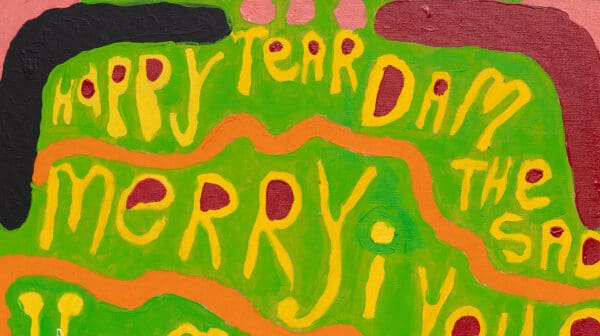One of the things I’ve noticed about older regional galleries is that many of them seem to have been built from the same design. The vestibule of the Queen Victoria Museum and Art Gallery in Launceston looks a lot like the entry to the Ballarat Regional Gallery in Victoria. It makes sense – an art gallery needs a big, sweeping staircase, triple height ceilings and polished floorboards, and both these venerable galleries are overflowing with old world charm.
The bigger regional galleries, those grand structures built in the 19th century from the wealth of the gold rush or local graziers, have other correspondences as well.
Many feature a commissioned drawing of the town as if seen from the air, or from an elevated tower or nearby hill. On opening day the crowds would have thronged to view the collection of English and select European paintings, and delight at the novelty of their very own town being pictured from afar. Other novelties in these galleries include portraits of local grandees, and my favourite, commissioned pictures of oversized cows and sheep, animals so large that the owner, invariably standing proudly next to the beast, barely manages to reach its shoulder.
Not every country town or city thought to build a permanent local gallery, or if they had, many didn’t survive to the present day.
To travel around to experience Australia’s wealth of regional galleries is to be presented with the architecture of make-do.
The Western Plains Cultural Centre, aka Dubbo Regional Gallery, out where the ground starts to turn red in western NSW, has a gallery space that was built from scratch: a large, high-ceilinged rectangular box with moveable interior walls. It’s a perfect space in that it can be reconfigured into seemingly countless layouts, and the architectural design yokes the new gallery to buildings that were once a high school. With a permanent collection of local history in the older building, there’s a harmony of experience as you wander from one space to the next, from old into new.
The Maitland Regional Gallery (MRG), in the Upper Hunter, is an older building that has been extended several times. The ground floor galleries are well-lit spaces that afford a museum quality hang while the upstairs and side rooms are a sprawling reminder of the timeworn building, an eccentric maze of short corridors, ramps and stairwells. Finding art there is a fun game of hide and seek. MRG also has what every decent regional gallery needs – a killer café/restaurant, one so good that when I’m travelling that way, I’ll make a detour off the Hunter Expressway to eat there.
About 45 minutes east is Newcastle and its formidable 1970s brutalist concrete gallery. It looks and feels like an extension of the Art Gallery of NSW, from the stairwell and its galleries, to the Brett Whiteley sculpture at the door, to the same Eurostyle Bold font on all the interior signage.
These galleries are the opposite ends of the regional gallery spectrum – the contemporary makeover of a heritage building, or a near-contemporary building that almost got a makeover. (Perhaps one day the Newcastle Council will come to its senses and, instead of spending the millions it had been given to upgrade the art gallery on local roads, it realises the commercial value of a major regional gallery.) Somewhere in the middle of that spectrum are regional galleries that are basically make-do spaces in 1980s era postmodern architecture, galleries that look identical to the council’s library, chambers and mothers’ health clinic. I won’t name names but they know who they are…
Of course, the thing that makes these galleries so valuable is their exhibitions.
While some have the luxury of permanent collections, most regional galleries have to spend wisely creating shows that balance between the interests of the local audience, and the possibility of attracting art tourists to their town.
While some wealthier museums and galleries can attempt to replicate the ‘Bendigo Effect’ (leapfrogging city art museums and bringing shows from overseas straight to the regions) most provide instead a venue for contemporary Australian artists to show their work.
For me, this is the most valuable aspect of regional galleries. Outside the commercial gallery system, and a handful of artist run initiatives in cities, there are remarkably few opportunities for artists to show their work, doubly so if they live in the regions. Regional galleries are usually run on a tight budget but they have proven to be remarkably adventurous, staging curated exhibitions, solo shows and local artists side-by-side. That regional galleries in close geographical proximity to each other haven’t yet got together to jointly promote themselves and stage a multi-venue exhibition is a great idea still waiting to happen.











